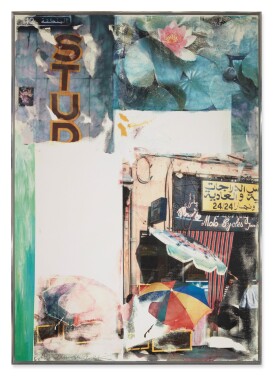
D ouglas S. Cramer, visionary art collector and prophetic cultural producer of television, made many of the most successful and recognizable television shows in history. Once head of Paramount Television and producing partner of Aaron Spelling, Cramer’s influence extended beyond the small screen and into the very heart of American culture from the 1960s- 2000s. His passion for Roy Lichtenstein paintings inspired the pop-art graphics used on the Batman series, and he used his commissioning patronage to convince Andy Warhol to make a guest appearance on The Love Boat. Cramer helped create and produce such iconic programs as The Brady Bunch, Star Trek, Wonder Woman and Dynasty found a meditative alternative to his frenetic workday at the studios in the captured images of his art collection. “There’s something wonderful in how the art is, well, frozen,” he told the New York Times in 1993. “At work, I’ll spend two or three or four hours looking at film, at moving images. But when I come home, the images stop.” The refuge he found in art eventually became his singular passion, retiring from television to focus on his collection with his beloved husband, Hugh Bush. He became one of the founders of the Los Angeles Museum of Contemporary Art, a member of the board and head of the important Painting and Sculpture Committee for the Museum of Modern Art in New York, and he donated funds and major artworks to numerous prominent institutions, including MOMA, The Whitney Museum, MOCA LA, and the Tate Modern. An impassioned, discerning, and generous connoisseur, Cramer built an astounding collection of some of the greatest masterworks of his generation.
View the Collection

“Like period rooms in museums, some collections are perfect time capsules, distilling, with exactly the right choices, the look of a particular moment in history. Douglas S. Cramer’s is one of these, it quickly cuts to the core of what seemed most to matter in the art world at a particular time and place.”
Having produced over 3000 hours of televised entertainment, Cramer built an inimitable career on his abiding passion for telling stories. This interest in storytelling is palpably evident in the Collection. Cramer, ever attuned to the world around him and with a prescient recognition of the zeitgeist, developed a keen interest in the art of his time and his collection evolved over the years to reflect the changing story of the moment. Beginning in the early 1960s with an interest in prints and drawings by modern masters, Cramer’s confidence in his own eye grew rapidly, and he soon began seeking out work by a younger generation of talent including Roy Lichtenstein, Ellsworth Kelly, and Jasper Johns, all of whom he came to know personally. Today considered mainstays of museums and art history textbooks, these mid-century titans are well represented in the Collection; for instance, Lichtenstein’s Two Paintings: Craig… is a quintessential expression of the artist’s Pop mode, featuring two of his most iconic motifs, the comic strip blonde and the brushstroke. Blue Panel with Green Curve (Diptych) is likewise a signature example of Kelly’s bold, colorful shaped canvases, an archetype of Minimalism. And, in its monochromatic surface and self-referential patterning, Johns’s Bushbaby from 2005 shows a mature master returning to the conceptual themes that underpinned his most famous works of the 1960s.

Never one to cling to the sentimentality of the past, however, Cramer did not limit his collecting passion to the art of his peers, but rather continued to support new generations of artists for over 50 years. Cecily Brown, whose work Cramer collected in depth, is strongly represented in the collection by several masterworks of the 1990s and early 2000s. The luscious, explosive surface of Spree 1999 stands in elegant conversation with the verdant, dynamic composition of Untitled (Trapeze) from 2002, and works by other younger artists like Elizabeth Peyton, Mark Grotjahn, and Lisa Yuskavage complement an overarching theme of the tensions between abstraction and figuration. While every work is a veritable archetype of each artist’s unique and distinctive practical mode, the Collection presents a sophisticated, insightful narrative of the crucial conceptual and aesthetic developments in the history of twentieth-century art-making.
“Somehow, for me, there's something wonderful in how the art is, well, frozen. At work, I'll spend two or three or four hours looking at film, at moving images. But when I come home, the images stop.”


















































